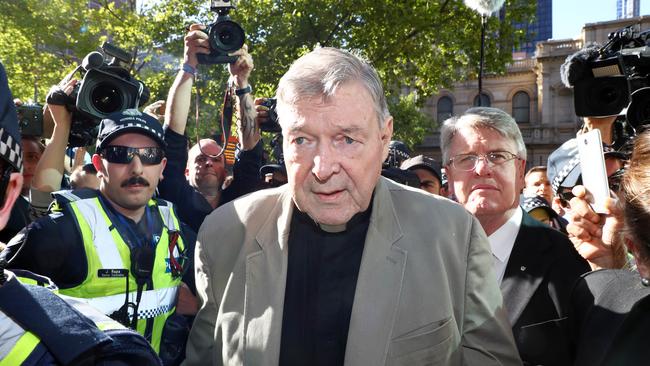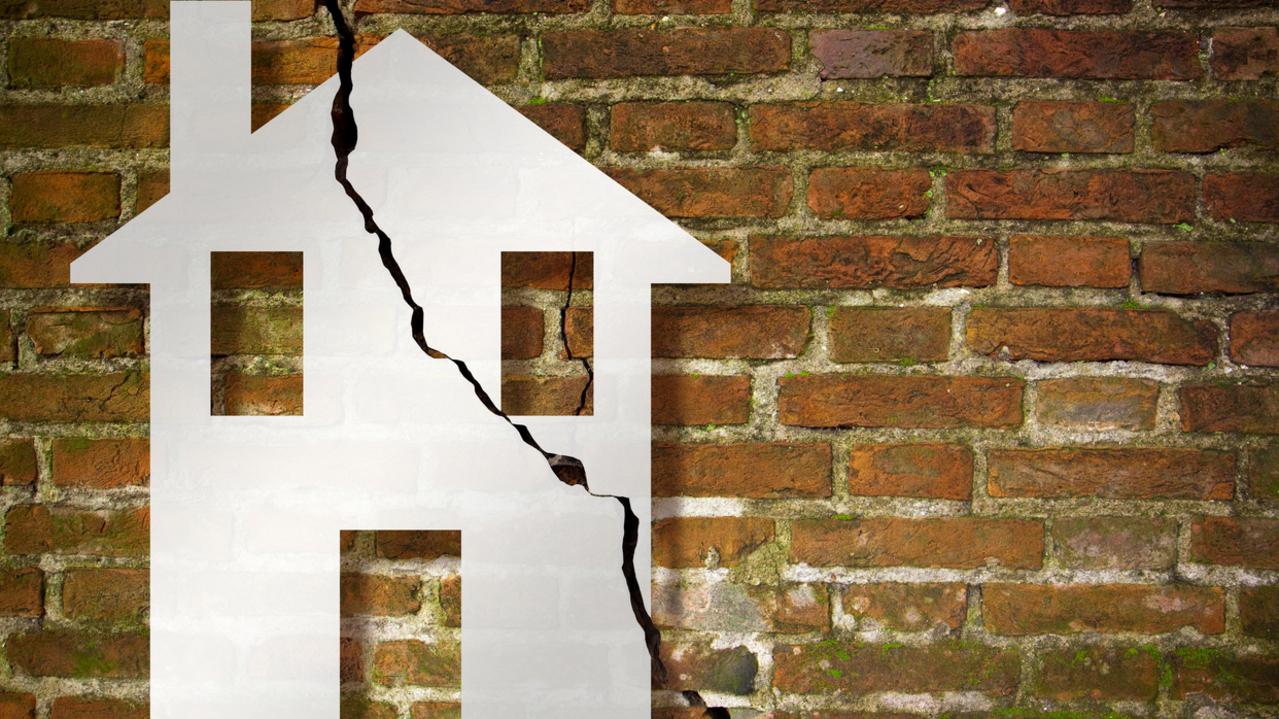Pell stands at the gate to freedom … or perdition
In his own form of purgatory, George Pell’s supporters say the cardinal remains resilient in prison.

George Pell has been in a form of legal and prison purgatory for three months. The Melbourne Assessment Prison is not so much a jail as it is a giant criminal sifting machine, where its 256 prisoners normally are dealt with rapidly after court and sent elsewhere.
The really bad boys go to Barwon and Port Phillip prisons, and the lesser of the offenders are sent into more relaxed bush detention.
Given the cardinal presents as such a complicated case, he has spent his days in solitary confinement awaiting appeal on the edge of Melbourne’s CBD in his maximum security halfway house.
At night, the MAP prisoners can hear the football at Marvel Stadium, and friends and relatives can sometimes talk to inmates from the Spencer Street footpath as the trains and trams rattle by.
It is so close to mainstream life that inmates occasionally drop their pants and salute workers in the high-rise buildings that cast their shadows over the exercise yards.
The dream for Pell, who friends say is “remarkably robust and optimistic” and appearing “strong and in good health”, is that his path to freedom begins at 9.30am on Wednesday when his case is heard in the Court of Appeal.
The appeal before three judges will last at most two days and will cement the 77-year-old convicted sex offender’s immediate future. Pell intends to attend the appeal. There is an outside chance the decision could be made next week, but most likely it will come in the weeks that follow.
There is no guarantee that Pell, if he were to lose this appeal, would have his case heard in the High Court, so there is an enormous weight on the shoulders of his silk, Sydney-based Bret Walker SC. Pell has had Rolls-Royce legal representation the whole way.
His six-year jail term for abusing two altar boys in 1996 and 1997 is one of the most controversial in Australian legal history, based as it is on a “he said, he said” second trial with limited corroborative evidence.
The convictions have divided the community and shattered the church the cardinal shepherded with vigour and controversy.
Boiled down, the argument for the convictions is that the sole living victim presented as a credible witness.
Having made the allegations to police in 2015, the former choirboy stood his ground (admirably, some have said privately) when interrogated and carried the jury to a guilty verdict in the second trial.
Jury members were so confident in the victim that they voted to lock up Pell for what would become a minimum three years and eight months, possibly a life sentence for someone turning 78 next week.
From the Pell perspective, the argument against the convictions is broad.
In its most simplistic terms, what his team argues is the evidentiary implausibility of Pell having struck in such breathtakingly brazen fashion after Sunday mass at St Patrick’s Cathedral, with the sacristy door open, the then archbishop weighed down by his robes and the first attack allegedly lasting up to five to six minutes. A now dead man who had denied ever being abused was the only possible corroborative witness inside the sacristy.
Even though Pell is a convicted sex offender, as ruled by the jury, there is furious debate within the Victorian Bar’s Essoign Club about the multiple convictions.
As much as the Pell abuse narrative is incredibly broad, going back to a first complaint against him relating to Phillip Island in 1961, the appeal must be analysed through the microscope of the law on the cathedral convictions.
And the fact a second jury ruled emphatically against the (still) cardinal. It is not about what people think of Pell, or the manner in which abuse claims have dogged him.
Legal experts canvassed by The Weekend Australian are divided about Pell’s prospects of winning.
Three judges of the Court of Appeal will preside over the hearing: Supreme Court of Victoria Chief Justice Anne Ferguson; Court of Appeal president Justice Chris Maxwell; and Justice Mark Weinberg. The appeal will be live-streamed on the Supreme Court’s website.
The prosecution during the County Court trials was led by Mark Gibson SC; there are no signs that either side will surrender and the loser is almost certain to want to see the case before the High Court.
There are three grounds of appeal but the Pell team will be looking for a knockout ruling that the jury verdicts were unreasonable and that it was not open for the court to be satisfied beyond reasonable doubt based on the word of the complainant.
If the Court of Appeal rules the verdicts were unsafe, Pell will be a free man, at least until any possible High Court intervention.
There are two other grounds of appeal that could lead to a retrial, although a retrial would be problematic and by no means a certainty.
The two other grounds for appeal are that the accused was not arraigned in the presence of the jury panel and that County Court Chief Judge Peter Kidd erred by preventing the defence from showing a visual representation of movements in the cathedral in the closing address.
University of Melbourne law school professor Jeremy Gans believes Pell has a reasonable chance of success before the Court of Appeal on the grounds of an unsafe verdict.
Acknowledging predictions can be fraught, Gans tells The Weekend Australian: “I think it has a good chance. What the ground (of appeal) does is basically request the Court of Appeal to decide for itself whether they have doubts about the accused’s guilt. There is a caveat that they are meant to take into account that the jury sees the evidence and the court doesn’t. But that doesn’t matter in this case because they can watch the same video that the jury saw of the complainant testifying. So basically, they are just going to be retrying Pell.’’
The Court of Appeal already has received submissions from both parties and will have been forensically examining the evidence and the circumstances of the offending.
Gans says there have been 10 successful appeals in Victoria in the past three years, seven in sex assault cases.
He says the reason the Pell appeal has a good chance of succeeding is that it will come down to the complainant’s evidence, as there is not even corroborating evidence that the victims were in the sacristy with Pell.
Monash University emeritus professor Arie Freiberg, a sentencing expert, says challenging an unsafe verdict is difficult because the jury are the people who have heard all the witnesses.
“They are challenging a jury’s verdict,’’ he tells The Weekend Australian. “And the judges have not heard the evidence and the judges have not heard the witnesses.’’
This ground differs from a straight judicial error and has the effect of challenging the jury “head on”.
“And I would imagine that would be difficult, given they’re the ones who heard all the witnesses,” Freiberg says.
David Galbally QC believes the Court of Appeal will be reluctant to second-guess the verdict.
“It’s really a question of whether the evidence was of sufficient weight,” he says.
“Could it, in fact, justify a verdict? My personal view is that it’s a very difficult argument to get up.”
The effect of the appeal against the convictions has been to leave both the surviving victim and the convicted sex offender in a legal limbo.
While the jury convicted Pell, the appeal has been like a caveat placed over a house, taking away the legal certainty.
As University of Sydney evidence expert David Hamer wrote earlier this year, the conviction appeared “provisional”.
Those close to the Pell case are convinced he has been robbed, the jury’s verdict suggesting the cardinal was everything they believe he isn’t.
Not surprisingly, his closest supporters reject that he was a reckless, brazen and opportunistic sex offender who struck while a door was open, while scores of people were wandering through the cathedral and while his closest church helpers were just metres away.
While the complainant impressed the jury, there were some reported contradictions in his evidence and the police interview of Pell in Rome, played to the court, was unconvincing in the detail of some of the accusations.
No one outside the court’s inner sanctum has actually seen the victim’s evidence against Pell because of his right to virtual anonymity under Victorian law, a fact that has made assessment of the second trial difficult.
The best insight into the victim’s plausibility is the manner in which prosecutor Gibson sang his praises in the closing.
Gibson’s lines to the jury are worth repeating: “I’d like you to step back for a moment and simply think about the overall impression that you are left with by the complainant’s evidence when it finished on the morning of 14 November.
“You got to spend time observing him, indeed for an extended period of time, under pressure, being cross-examined and probed extensively by an experienced member of counsel in (Robert) Richter. So what was the overall impression you were left with? Did he strike you as an honest witness?
Gibson would not have relied so heavily on the complainant if he didn’t think he was the case’s ultimate weapon. This could well be Pell’s biggest challenge.
It is almost certain the appeal judges will watch the video of the choirboy’s cross-examination, which was replayed to the second jury. They will want to know what the jury was thinking when the victim had his say.
For the Catholic hierarchy, there is a sense of bewilderment about Pell’s predicament.
Throughout his three court cases — two trials and a committal — there was significant optimism. That optimism has understandably dissipated as the cardinal is now a convicted sex offender spending 23 hours a day in solitary confinement.
His visitors are “incredibly impressed” with his resilience but are not surprised. He remains a man of great faith.
But in the background, the church is wondering how to take itself forward in the post-Pell era.
The energy of survivor groups and their advocates has not waned. All but one of the Pell accusers in the cathedral and swimming pool trials did not have their claims substantiated but it doesn’t rule out more allegations emerging.
The Pell passages in the sex abuse royal commission report that were redacted will eventually be published and it can only be speculated on whether this is good or bad for the cardinal’s shattered reputation.
Meanwhile, a lot of very good people are still serving the church in the face of relentless criticism and obstacles.
This, along with the disastrous impact on the church’s abuse victims, their family and friends, is the long-term effect of the abuse scandal.
But it shouldn’t stop Pell having his days in court.
If the jury got it wrong, the Court of Appeal will hold it to account. Anything less would be a miscarriage of justice.



